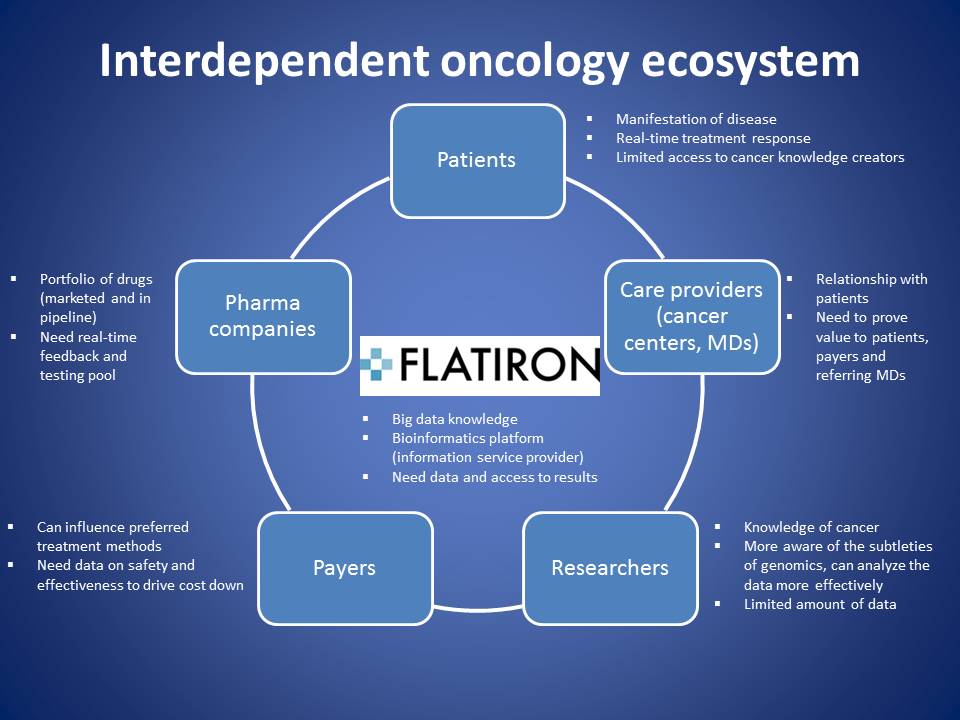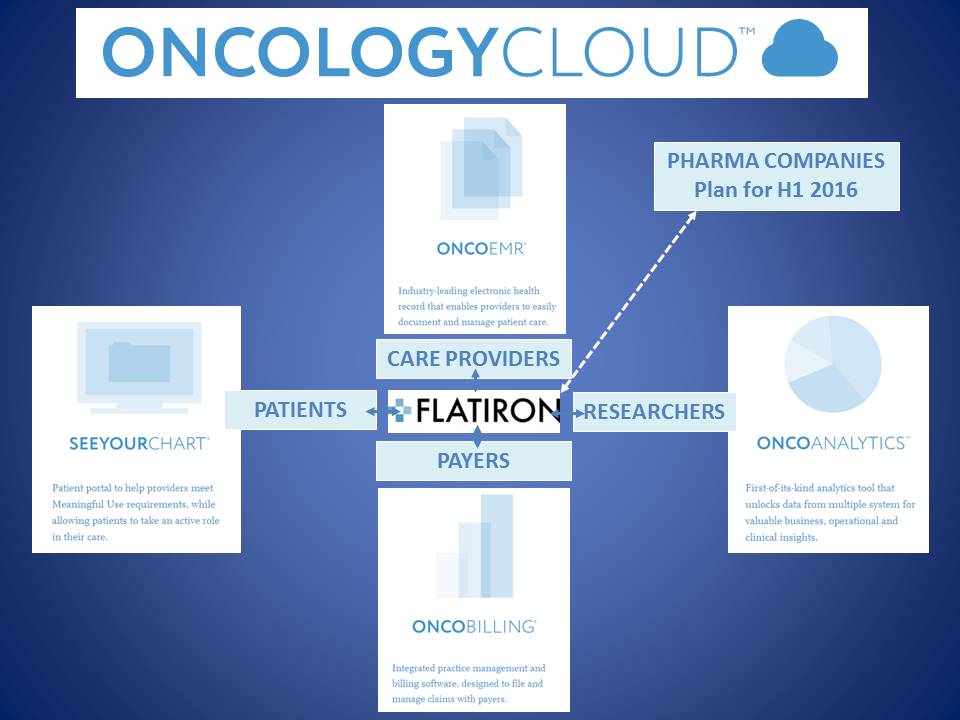Flatiron: Fighting Cancer Online

Flatiron Health is powering the most advanced cloud-based oncology software to support cancer care. It received $130 million from Google Ventures in 2014. Since, Flatiron has embarked on an exponential growth track pulling thousands of the best oncologists and cancer centers in the world to the platform.
Flatiron is tapping into a huge market opportunity. 8 million people die of cancer and 14 million find out they have the disease every year. The cancer drug market itself just hit $100 billion and could jump by 50% in four years according to Forbes. Flatiron Health was founded in 2012, received $130 million from Google Ventures in 2014 and has created an enormous pull-effect momentum over the last 5 months. What is their secret sauce?
Flatiron Health brings value to incumbent healthcare players by creating multi-sided platform and leveraging direct and indirect network effects
Flatiron created a software platform connecting and standardizing cancer centers around the world. There are benefits for each party involved, and the more players join, the bigger the benefits are. Patients can take an active role in their care. Researchers gain access to amount of data never imaginable before. Payers can track the safest and most effective treatments to drive the cost down. Cancer care providers can prove value to patients, payers and referring MDs by transparent sharing of results. Pharma companies can get real-time, objective feedback on the drug efficacy.
The interdependence and mutually beneficial ecosystem is demonstrated in the attached scheme.
More and more cancer players are being drawn to Flatiron creating barriers to entry
Over the last couple of months, Flatiron has locked into its platform the biggest data players in chemotherapy, radiotherapy and blood cancer diagnostics, thus creating enormous barriers to entry for any potential competitor. On the top, Flatiron unlocked an enormous innovation potential between the individual treatment approaches, with significantly reduced response time and risk.
Flatiron created a partnership to launch novel oncology outcomes database with National Comprehensive Cancer Network (NCCN) in January 2015. NCCN is a non-profit alliance of 26 cancer centers dedicated to improving the quality and effectiveness of care for cancer patients. Great approach, NCCN is considered to be an arbiter of high-quality cancer care. By May 2015, Flatiron has already incorporated NCCN chemotherapy order template into its proprietary OncoEMR®.
In May 2015, Flatiron stroked two more powerful deals. First, Flatiron fully integrated into its software platform Via Oncology, a network of 1,100 oncology providers. Second, Flatiron pursued a strategic alliance with Varian Medical Systems, the world’s leading manufacturer of medical devices and software for treating cancer with radiotherapy, radio surgery, and proton therapy. OncoEMR® has thus gained a seamless access to Varian’s software used by 3,800 cancer centers.
Guardant Health cancer blood screening product (Guardant360) was integrated in August 2015. Flatiron can thus access the most time – and cost-effective data collection from both diagnostics and drug therapy results.
Who is losing to Flatiron? The most re-known and big-headed medical institutions
Flatiron opened its platform to various players and took a pro-active role in coaching them to use the platform. On the contrary, the traditional majors, such as Sloan Kething and Mt Sinai’s Icahn Institute took a different approach. These players fought to protect their data, considering themselves to be THE centers of excellence. If you wanted to have access to the data, you could purchase the license for a very high fee. By being over-protective, they are limiting themselves to a dwarf dataset compared to what can (and will be) available in the Flatiron platform.
Flatiron has already developed interfaces for four of the main stakeholders. Negotiations with pharma players are expected in first half of 2016.
Healthcare is one of the most affected industries by digital and big data disruption. Flatiron Health was founded by two of the founders of Invite Media, an advertising technology company acquired by Google.





Emilie, great post! I agree that Flatiron is disrupting the healthcare industry with its technology.I’m curios to know what were the regulations they had to face, and if there is a risk that in the future they might not be able to operate because of regulations/licences/privacy issues.
Flatiron claims it has industry-best technical security standards in place to encrypt and protect data at every point. On the top, it claims that Flatiron has met or exceeded the expected HIPAA (Health Insurance Portability and Accountability Act) standards. http://www.flatiron.com/legal/hipaa
Patients who undergo a clinical trial have to give a green light to the data release. Flatiron made a smart move when it established cooperation with all the cancer care centers who “received” previously the green light from their patients. Thinking about future, I would expect that regulation in this respect has to change significantly to the benefit of Flatiron and similar companies. In the end, it is in the ultimate interest of humans to have cancer research advance using the data (compared for example to Facebook that uses our personal data for commercial reasons).
Great post, and extremely exciting business model! In many technology sectors – but possibly most acutely in digital health – there are more and more platforms emerging that facilitate this type of large scale data collection and data sharing. I don’t think anyone will argue with the intense value that this data represents, but I actually think that the greater value will be realized by the companies that ultimately figure out what to DO with this data. Meaning, the companies that figure out how to write algorithms/build dashboards/develop workflows that drive actionable responses to this data.
The first step is definitely data collection, but I’m even more excited for the days of data driven action against these major diseases!
Thank you for your comment! I believe the “what to DO with the data” should be the sweet spot of Flatiron. I am judging based on the profile of the two co-founders (big data advertising technologies). This is what excites me – how we can drive innovation by cross-pollinating ideas from completely different industries.
Thanks for the interesting post Emilie and KMY for writing exactly what I was thinking as I read it! I actually wonder if big data advertising is actually the right background for understanding how to harness the data. Advertising seems pretty far removed from improving healthcare delivery and drug development, and ultimately those must be some of the big goals for what to do with the data.
Emilie, thank you for the exciting post! KMY and Angela, your comments on how the data will be used/advertised are important points to consider. While I believe that the tone of Flatiron’s messaging is as Emilie has described, I wonder if the goal isn’t perhaps more sinister. This platform seems like an excellent way, for example, for Guardant Health to lock up customers, which is a good thing for society only so long as their diagnostics remain best in class (likely a brief window, given the pace of development in this area and ironic, given the position of Sloan Kettering and Mt. Sinai Ichan). I see Flatiron as a valuable platform in this area, but I worry that their connections to customers could be co-opted by partners in ways that are not going to be beneficial to patients in the long term.
Great thinking! I have not thought about it this way. I still believe that this platform can deliver big innovation potential mid-term (getting access to much larger portfolio of patient data, currently only 4% of US patients with cancer participate in clinical trials, and combining the dofferent treatment options). The question remains, how to be innovative & self-disruptive long-term (how not to become just a cash cow of the plaform lock-in effect as we saw in the simulation).
Great push, Angela! I believe big data advertising skills would bring value only if combined with the researchers’ cancer analytics skills. I see Flatiron “helping the researchers who master their local “pond” knowledge navigate the deep and large ocean waters”. Big data advertising has a spike in understanding drivers and responses across heterogenous audiences.
Great post! I wonder what will happen to the traditional model of academic center research when other areas in medicine follow this trend. Data should be available more ubiquitously, and this could have a huge impact on the current scientific landscape!
Thank you for your comment! I see the future of academic research getting inspired by big data. If I had a lab, I would create a team of a top big data analyst working side-by-side with my top biologists. There is so much potential for cross-pollination of ideas!